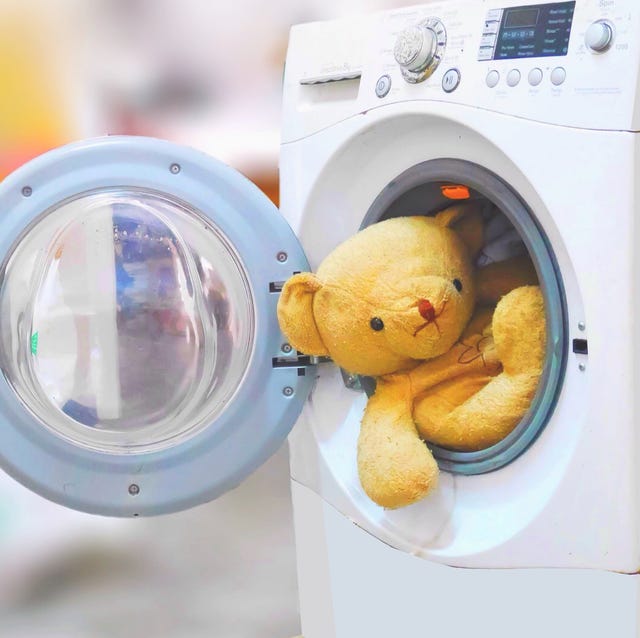

Let's face it: Your child's toys are their most prized possessions, often by his or her side 24/7. That means they get played with, tossed around, slept with, chewed on and who knows what else? Before long, that beautiful, pristine teddy bear looks like a gnarly mess. Besides the visible dirt and grime, toys can harbor germs, allergens or worse, mold.
Different toys require different cleaning methods not only to get them clean, but to keep them looking and working their best. Below, our Good Housekeeping Cleaning Lab recommends how — and how often — to clean and kill germs on toys to help keep your children safe.
How frequently toys need cleaning depends on how loved they are (a.k.a how much they get played with). These are general guidelines for when your child is healthy. It's always important to clean and sanitize toys more frequently when your child is ill or has the flu and to do it all again once they've recovered.
In a word, no. Vinegar is a great household grease cutter and limescale remover and while it can kill some germ strains, it's not powerful enough to reach the sanitizing and disinfecting levels required to be recognized and registered by the EPA. You are better off just washing toys in hot sudsy water to clean them.

If you are looking for a more natural, plant-based alternative to chemical disinfectants, products like Seventh Generation Disinfecting Wipes, kill germs with thymol, a component of thyme oil. They are EPA registered, but keep in mind that they work more slowly than traditional disinfecting wipes and the surface needs to stay visibly wet for 10 minutes to be the most effective.
Solid plastic toys, like rubber rings, animal figures and building blocks and bricks can easily be cleaned in your dishwasher's top rack. Here's how:
You can also disinfect or sanitize all colorfast plastic baby and children's toys with:
Be sure to keep the toy's surface wet for at least 10 seconds to sanitize with a wipe (or for the time recommended on the product's label) and for five minutes to disinfect with the bleach and water solution and let it air dry. Always make a fresh bleach solution each time. While these are all safe ways to clean, sanitize and disinfect baby and children's toys, after air drying, you should always give them another thorough warm water rinse and let them air dry again. This will remove any remnants of the cleaning solution.
Keep in mind: Bath toys with holes in the bottom are particularly problematic. When water gets trapped inside, mold grows. Even mesh toy caddies may not allow enough air to circulate to completely dry the toys inside. It's safest to avoid using hollow toys with holes — even rubber duckies — in the bathtub, but if you do, make sure to vigorously shake or squeeze out as much water as you can and allow them to thoroughly air dry after each use. If you ever see mold inside a toy or mold comes out when you shake or squeeze it, immediately toss the toy out.
Colorfast, plain stuffed animals and fabric books are usually safe to clean in your washing machine. Sturdy plush toys can be washed and dried on the sanitizing cycles, if your machines have them, but many plush toys come with care labels, so it's a good idea to check how the manufacturer recommends cleaning it, especially if the toy is new. Here's how to clean 'em in the washer:
Keep in mind: Never wash plush toys with built-in battery packs, noise makers or other metal parts, as the water may damage them. Make sure all decorations and buttons are securely attached, any rips and holes are repaired.
Some toys can only stand up to hand washing. Before tossing a toy in the washer, check the colorfastness of all fabrics and trims on the toy with a drop of water. If the color bleeds when you blot the drop with a paper towel, don't machine wash it. Spot clean it instead. You'll also want to hand wash delicate stuffed toys that can only handle surface cleaning. Here's how to hand-wash and spot clean stuffed toys:
Just like your TV's remote control, electronic toys can usually only take surface cleaning. Start by turning off and disconnecting the toy or removing any batteries (but replace the battery compartment cover) before cleaning. Here's how:

Lynn Redmile (she/her) is a contributing product reviews analyst at the Good Housekeeping Institute, where she's been evaluating nutrition, fitness, beauty, textiles, home, pet, and cleaning products since 2012. She brings over 30 years of data analysis and project management experience to the role.
Home Care & Cleaning Lab Executive DirectorCarolyn Forté brings more than 40 years of experience as a consumer products expert to her role as executive director of the Good Housekeeping Institute's Home Care and Cleaning Lab. Using deep analytical testing and writing expertise in appliances, cleaning, textiles and organizational products, she produces cleaning and home care advice for GH, has authored numerous books and bookazines for the brand and partners with the American Cleaning Institute to co-produce the Discover Cleaning Summits. She holds a bachelor's degree in family and consumer sciences from Queens College, City University of New York.